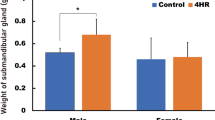Abstract
Male C57BL/6×DS-F1 mice that had been treated with 3′-methyl-4-dimethylaminoazobenzene (3′-Me-DAB) neonatally were subjected to sialoadenectomy (removal of the submandibular salivary glands) 60 days after birth. The development of adenomatous nodules and carcinomas in the livers of these mice was compared with the livers of males without sialoadenectomy. The incidence of adenomatous nodules in sialoadenectomized males at 6, 8, 10, and 12 months was significantly lower than that in sham-operated animals. Carcinomas were found in the livers of both sham-operated and sialoadenectomized males that were 10 and 12 months old and were less frequent in sialoadenectomized males although the difference was significant only at the age of 12 months. Sialoadenectomy decreased the serum concentration of epidermal growth factor (EGF) by about 40%. The present results indicate that sialoadenectomy inhibits the development of hepatocellular tumours induced by 3′-Me-DAB in male mice, an effect which may be caused by decrease in the serum level of EGF.
Similar content being viewed by others
References
Alm J, Lakshmanan J, Fisher DA (1986) Sexual dimorphism and testosterone effects on liver epidermal growth factor receptors in mice. Acta Endocrinol (Copenh) 113:140–144
Byyny RL, Orth DN, Cohen S, Doyne E (1974) Epidermal growth factor: effects of androgens and adrenergic agents. Endocrinology 95:776–782
Carpenter G. Cohen S (1979) Epidermal growth factor. Annu Rev Biochem 48:193–216
Chester JF, Gaissert HA, Ross JS, Malt RA (1986) Pancreatic cancer in the Syrian hamster induced by N-nitrosobis(2-oxopropyl)-amine: carcinogenic effect of epidermal growth factor. Cancer Res 46:2954–2957
Fisher DA, Lakshmanan J (1990) Metabolism and effects of epidermal growth factor and related growth factors in mammals. Endocr Rev 11:418–442
Frith GH, Baetcke KP, Nelson CJ, Schieferstein G (1980) Sequential morphogenesis of liver tumors in mice given benzidine dihydrochloride. Eur J Cancer 16:1205–1216
Inui T, Tsubura A, Morii S (1989) Incidence of precancerous foci of mammary glands and growth rate of transplantable mammary cancers in sialoadenectomized mice. J Natl Cancer Inst 21:1660–1663
Kasayama S, Yoshimura M, Oka T (1989) The regulation by thyroid hormones and androgen of epidermal growth factor synthesis in the submandibular gland and its plasma concentrations in mice. J Endocrinol 121:269–275
Kashimata M, Hiramatsu M, Minami N (1989) Differential secretory rhythm of growth hormone controls the number of hepatic epidermal growth factor receptors in the rat. J Endocrinol 123:75–81
Kemp CJ, Leary CN, Drinkwater NR (1989) Promotion of murine hepatocarcinogenesis by testosterone is androgen receptor-dependent but not cell autonomous. Proc Natl Acad Sci USA 86:7505–7509
Kurachi H. Okamoto S, Oka T (1985) Evidence for the involvement of the submandibular gland epidermal growth factor in mouse mammary tumorigenesis. Proc Natl Acad Sci USA 82:5940–5943
Lipsky MM, Hinton DE, Klaunig JE, Trump BF (1981) Biology of hepatocellular neoplasia in the mouse. I. Histogenesis of safrole-induced hepatocellular carcinoma. J Natl Cancer Inst 67:365–376
Marti U, Burwen SJ, Jones AL (1989) Biological effects of epidermal growth factor, with emphasis on the gastrointestinal tract and liver; an update. Hepatology 9:126–138
Moore MR, Drinkwater NR, Miller EC, Miller JA, Pitot HC (1981) Quantitative analysis of the time-dependent development of glucose-6-phosphatase-deficient foci in the liver of mice treated neonatally with diethylnitrosamine. Cancer Res 41:1585–1593
Noguchi S, Ohba Y, Oka T (1991) Influence of epidermal growth factor on liver regeneration after partial hepatectomy in mice. J Endocrinol 128:425–431
Noguchi S, Ohba Y, Oka T (1991) Pretranslational enhancement of epidermal growth factor receptor by direct effect of testosterone in mouse liver. Endocrinology 128:2141–2148
Perheentupa J, Lakshmanan J, Hoath SB, Beri U, Kim H, Macaso T, Fisher DA (1985) Epidermal growth factor measurements in mouse plasma: method, ontogeny, and sex difference. Am J Physiol 248:E391-E396
Rose SP, Stahn R, Passovoy DS, Herschman H (1976) Epidermal growth factor enhancement of skin tumor induction in mice. Experientia 32:913–915
Sandgren EP, Luetteke NC, Qiu TH, Palmiter RD, Brinster RL, Lee DC (1993) Transforming growth factor alpha dramatically enhances oncogene-induced carcinogenesis in transgenic mouse pancreas and liver. Mol Cell Biol 13:320–330
Takagi H, Sharp R, Takayama H, Anver MR, Ward JM, Merlino G (1993) Collaboration between growth factors and diverse chemical carcinogens in hepatocarcinogenesis of transforming growth factor α transgenic mice. Cancer Res 53:4329–4336
Toh YC (1973) Physiological and biochemical reviews of sex differences and carcinogenesis with particular reference of the liver. Adv Cancer Res 18:155–209
Vesselinovitch SD, Mihailovich N, Rao KVN (1978) Morphology and metastatic nature of induced hepatic nodular lesions in C57BL×C3H F1 mice. Cancer Res 38:2003–2010
Vesselinovitch SD, Itze L, Mihailovich N, Rao KVN (1980) Modifying role of partial hepatectomy and gonadectomy in ethylnitrosourea-induced hepatocarcinogenesis. Cancer Res 40:1538–1542
Weghorst CM, Klaunig JE (1989) Phenobarbital promotion in diethylnitrosamine-initiated infant B6C3F1 mice: influence of gender. Carcinogenesis 10:609–612
Yamamoto B, Iishi H, Tatsuta M, Tsuji M, Terada N (1991) Roles of ovaries and testes in hepatocellular tumorigenesis induced in mice by 3′-methyl-4-dimethylaminoazobenzene. Int J Cancer 49:83–88
Yoneda T, Alsina MM, Watatani K, Bellot F, Schlessinger J, Mundy GR (1991) Dependence of a human squamous carcinoma and associated paraneoplastic syndromes on the epidermal growth factor receptor pathway in nude mice. Cancer Res 51:2438–2443
Author information
Authors and Affiliations
Rights and permissions
About this article
Cite this article
Yamamoto, R., Iishi, H., Tatsuta, M. et al. Inhibitory effect of sialoadenectomy on hepatocellular tumourigenesis in male mice induced by 3′-methyl-4-dimethylaminoazobenzene. Vichows Archiv A Pathol Anat 425, 79–82 (1994). https://doi.org/10.1007/BF00193953
Received:
Accepted:
Issue Date:
DOI: https://doi.org/10.1007/BF00193953




